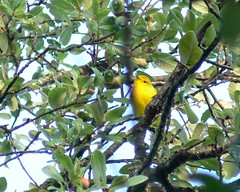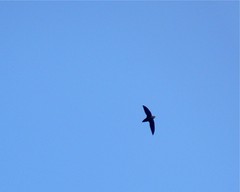I drank way too much wine with my neighbors last night at our monthly wine club, so this morning I decided to sleep in a bit and stay home. I spent an hour and a half birding my yard starting at about 7:30. There were no huge surprises, but I found 21 species of birds and enjoyed a beautiful cool and partly cloudy morning in the yard. Besides most of the usual year-round resident species like Carolina Chickadee, Black-crested Titmouse, Carolina Wren, Bewick's Wren, Northern Cardinal, European Starling, and White-winged Dove, I got some great looks at (and a poor photo of) this bright Yellow Warbler, which is one of the most common fall migrating warblers in central Texas.
I also heard and finally saw a Great Crested Flycatcher in the front yard, a species that summers in our neighborhood. At this time of year I assume the bird I saw was passing through on its way south.
Another common neighborhood summer resident species I saw this morning was the Chimney Swift. These neat little dark grey (almost black) birds can be found in the open sky hunting flying insects. They make a distinctive twittering call which will always be linked with bright summer days in my mind. The shape of this bird in the air is very simple and clean. Since this bird often flies without its tail spread, its body looks like a long slender oval. Its wings are simple curved sickles coming off both sides. The old Peterson field guides say a Chimney Swift looks like "a cigar with wings". Here's one that flew over my house today.
Chimney Swifts fly around all day, rarely or never perching until they roost at night. Their roosting and nesting sites were originally hollow tree trunks in the old-growth forests of the eastern United States. As these hollow trees became scarcer with the loss of the forests, these birds made a very interesting adaptation. They started using the chimneys of houses and other buildings built by European settlers. It's thought that their population actually grew from this adaptation. But as old chimneys eventually deteriorate and are replaced by newer ones that are capped or are otherwise unsuitable for these birds, their population has been declining.
There are some very interesting efforts to provide more nesting and roosting sites for Chimney Swifts. Small chimney-like towers can be built just for these birds. (Pat Powers on Stillforest built one of these towers in his backyard, with a video camera inside!) Also many existing chimneys on regular houses can be made suitable for use by these birds simply be uncapping them. More information is available at ChimneySwifts.org.
By now these birds are heading south and can be found in larger groups up in the sky. Listen for them and try to find some of these neat little birds chattering and wheeling around up there!



No comments:
Post a Comment